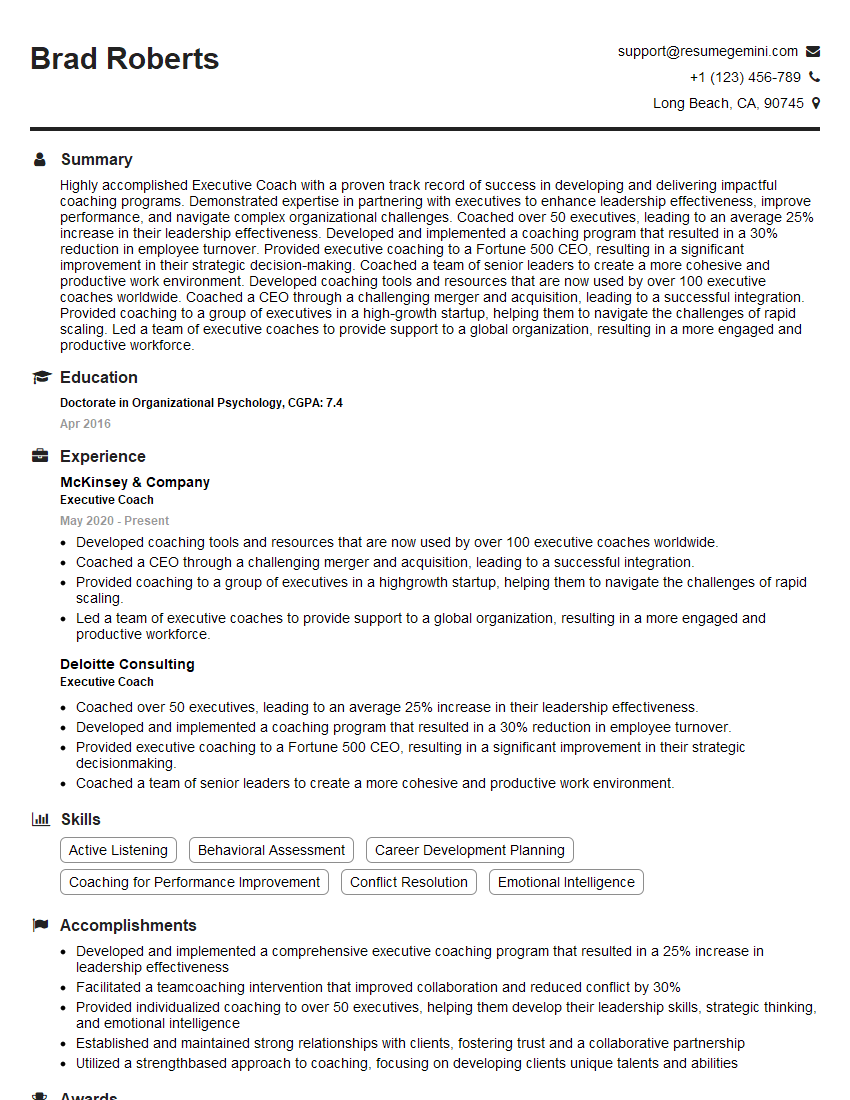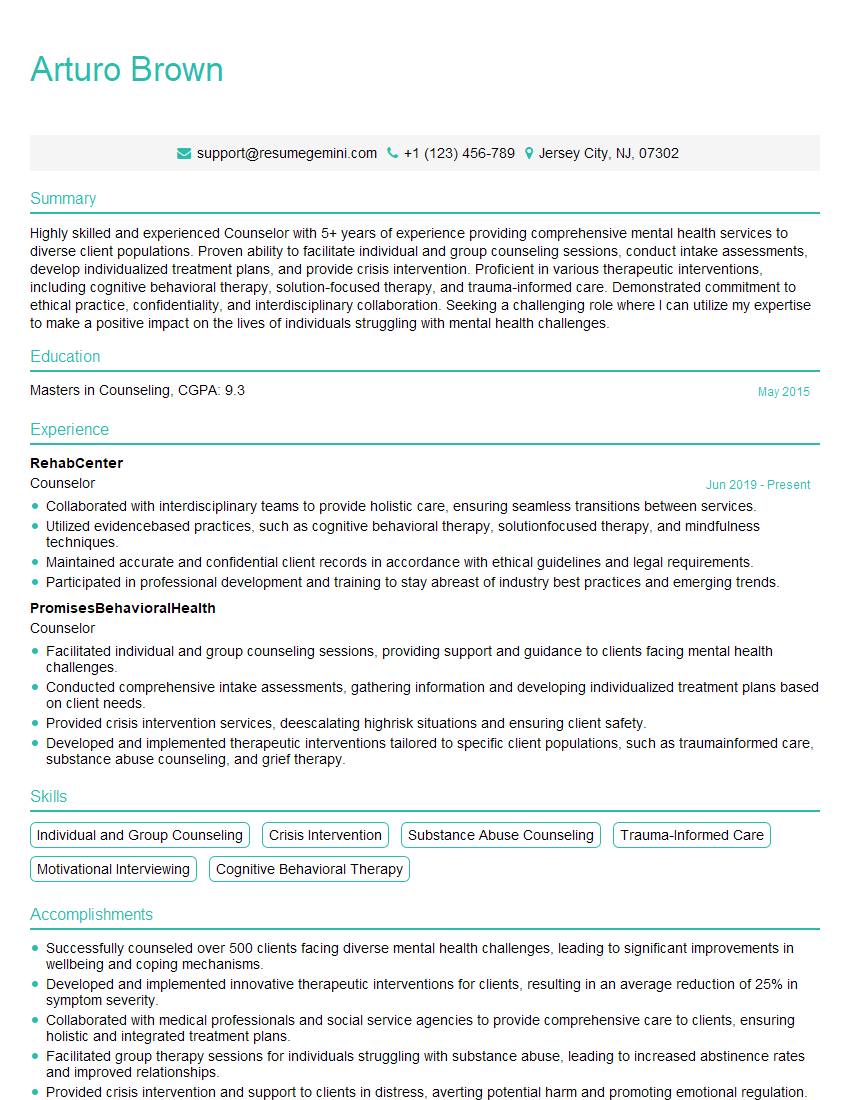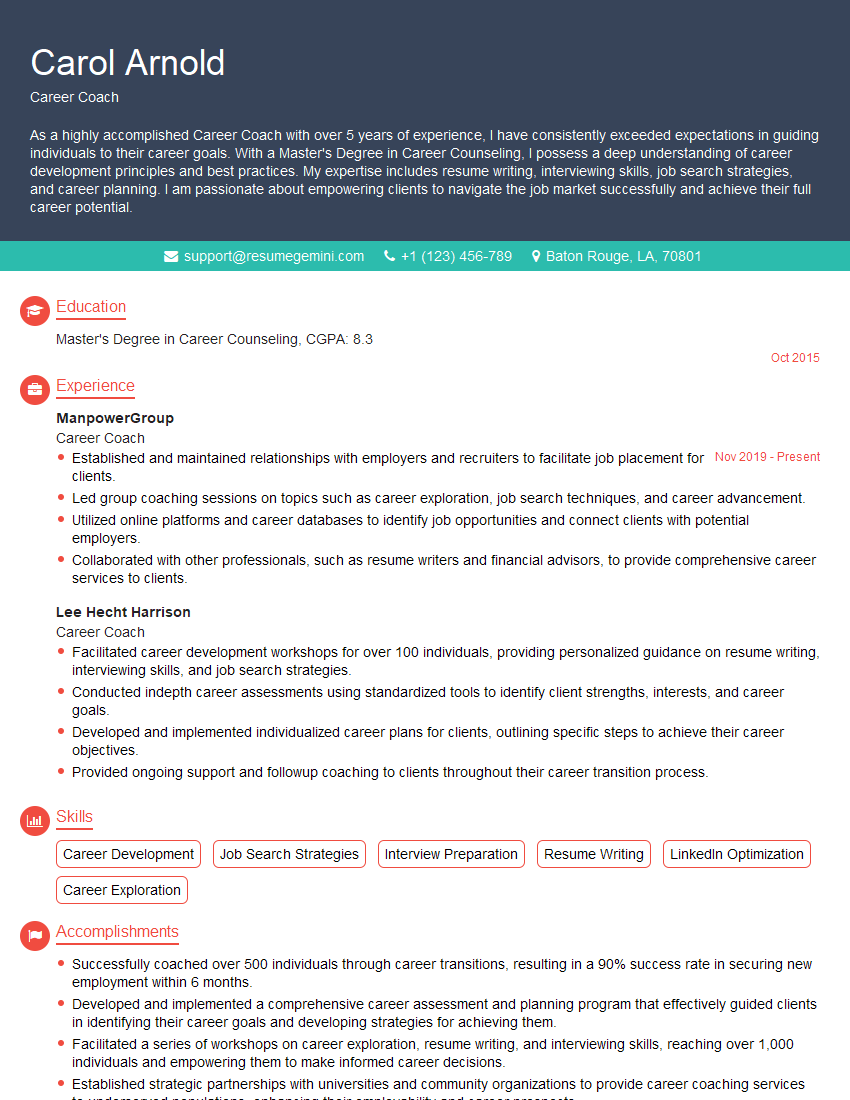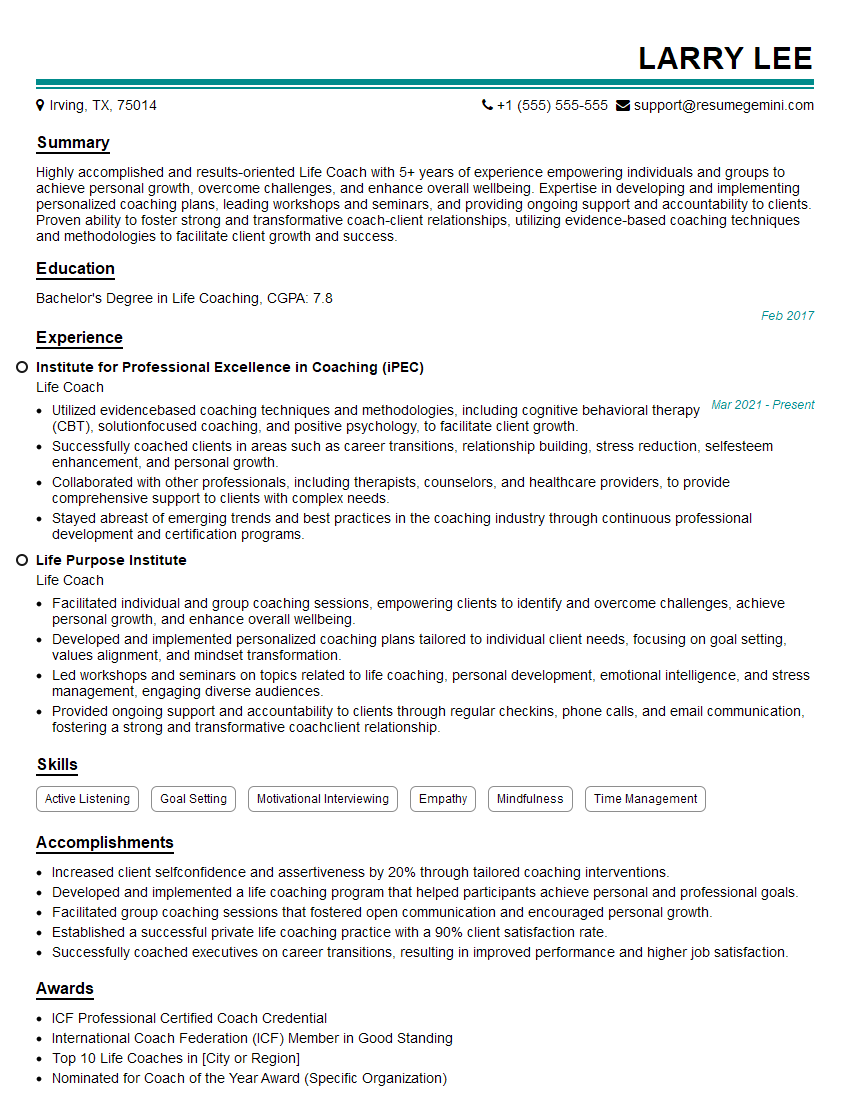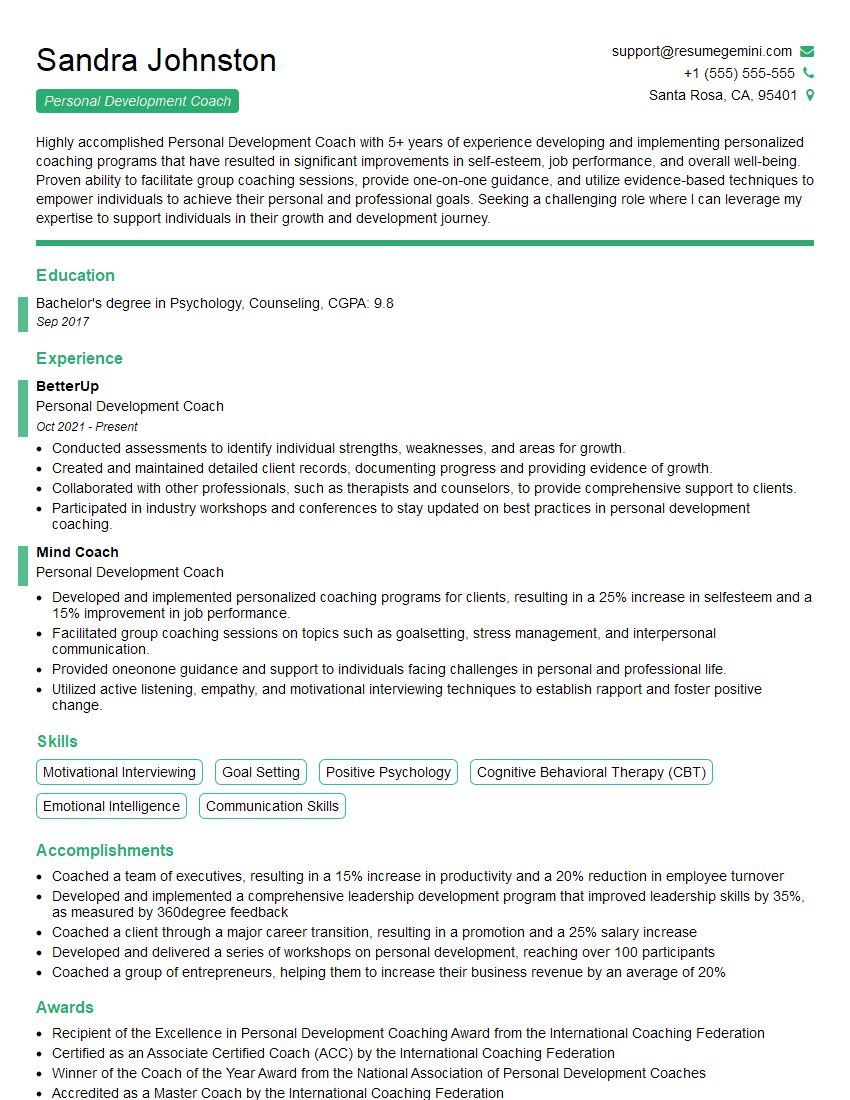Every successful interview starts with knowing what to expect. In this blog, we’ll take you through the top Mentoring and Support interview questions, breaking them down with expert tips to help you deliver impactful answers. Step into your next interview fully prepared and ready to succeed.
Questions Asked in Mentoring and Support Interview
Q 1. Describe your experience developing mentoring programs.
Developing successful mentoring programs requires a structured approach encompassing several key phases. It starts with defining clear program goals – what skills or outcomes do we want mentees to achieve? Then, we need to identify and recruit suitable mentors, considering their experience, communication skills, and empathy. A robust matching process is crucial, pairing mentors and mentees based on shared interests, personality traits, and career goals. The program structure itself should outline expectations, meeting frequency, and activities. Finally, ongoing evaluation and feedback mechanisms are essential to ensure the program remains relevant and effective.
For example, in my previous role, I developed a leadership mentoring program for a tech startup. We carefully selected mentors based on their leadership experience and their ability to provide tailored guidance. We used a survey to understand mentees’ career aspirations and matched them with mentors accordingly. The program involved structured one-on-one meetings, workshops on leadership skills, and group networking events. We regularly collected feedback through surveys and focus groups, allowing us to adapt and improve the program over time.
Q 2. How do you assess the needs of a mentee?
Assessing a mentee’s needs is a multifaceted process that goes beyond simply understanding their career goals. It involves active listening, careful observation, and using various assessment tools. I typically begin with an initial meeting to understand the mentee’s background, aspirations, and current challenges. This is followed by a needs assessment, which can involve questionnaires, personality assessments (like Myers-Briggs), or skills gap analyses. Understanding their learning style – visual, auditory, kinesthetic – is also crucial in tailoring the mentoring approach. Finally, I discuss their strengths, weaknesses, and areas they want to improve, ensuring a collaborative approach to goal setting.
For instance, one mentee I worked with expressed a desire to improve her public speaking skills but struggled with anxiety. Through a needs assessment, I discovered she was a kinesthetic learner, benefiting from hands-on practice. Therefore, our mentoring sessions incorporated role-playing and presentations to a smaller group, building her confidence gradually.
Q 3. What strategies do you use to build rapport with mentees?
Building rapport is foundational to effective mentoring. It’s about creating a safe and trusting environment where the mentee feels comfortable being vulnerable and honest. I prioritize active listening, demonstrating genuine interest in their experiences and perspectives. I use open-ended questions to encourage them to share their thoughts and feelings. Showing empathy and validating their emotions is crucial. I also strive to find common ground, creating a personal connection that goes beyond the professional context. Building trust takes time, but consistent effort in demonstrating respect, understanding, and confidentiality goes a long way.
In one instance, I started a mentoring session by sharing a relatable anecdote about a similar challenge I faced earlier in my career, making the mentee feel less alone and more comfortable sharing their own experiences.
Q 4. Explain your approach to providing constructive feedback.
Constructive feedback is about helping the mentee learn and grow, not about criticizing or judging. My approach is always framed with the goal of helping them achieve their objectives. I use the SBI (Situation-Behavior-Impact) model, describing the specific situation, the observed behavior, and the impact it had. I focus on observable behaviors rather than making generalizations about their personality. I also make sure to provide both positive feedback on their strengths and areas for improvement, balancing encouragement with suggestions for growth. The feedback is always delivered privately and respectfully, allowing for a two-way dialogue and an opportunity for the mentee to ask questions and share their perspectives.
For example, instead of saying ‘You’re not assertive enough,’ I might say, ‘In the team meeting yesterday, you didn’t speak up when you had a relevant point. This meant your valuable input wasn’t considered. Perhaps practicing articulating your opinions in advance of meetings could help.’
Q 5. How do you handle conflict between mentees?
Conflict between mentees is rare in my experience, but if it arises, my approach is to facilitate a constructive conversation rather than mediate. I create a safe space for them to express their concerns respectfully. I encourage active listening and help them understand each other’s perspectives. I help them identify the root cause of the conflict, focusing on the issue rather than placing blame. I work with them to develop mutually acceptable solutions, empowering them to resolve the conflict themselves. If the conflict persists, I might suggest they work separately with me or refer them to other resources for conflict resolution.
The key is to ensure all parties feel heard and respected, fostering a collaborative resolution process.
Q 6. Describe a time you had to adapt your mentoring style to a mentee’s learning style.
I once mentored a visual learner who struggled to grasp complex concepts explained verbally. Initially, I relied heavily on explanations and discussions, but I quickly realized this wasn’t effective. I adapted my approach by incorporating visual aids like diagrams, flowcharts, and presentations. I also encouraged the use of mind maps and other visual tools to help them organize their thoughts and ideas. This shift significantly improved their understanding and progress, highlighting the importance of adjusting to individual learning preferences.
Q 7. How do you measure the success of a mentoring program?
Measuring the success of a mentoring program involves both qualitative and quantitative data. Quantitative data can include metrics like the number of mentoring sessions completed, mentee satisfaction scores (through surveys), and their progress towards their goals (tracked through self-assessment or performance reviews). Qualitative data can be collected through interviews, focus groups, and observations to understand the impact of the program on the mentees’ personal and professional development. This can involve assessing changes in self-confidence, skill acquisition, career progression, and overall well-being. Analyzing this combined data provides a comprehensive picture of the program’s effectiveness and allows for continuous improvement.
Q 8. What are some common challenges in mentoring and how do you address them?
Mentoring, while incredibly rewarding, presents several challenges. One common hurdle is the mismatch of expectations between mentor and mentee. The mentee might have unrealistic goals, while the mentor might underestimate the time commitment. Another challenge is communication difficulties; differing communication styles can lead to misunderstandings and frustration. Finally, time constraints on both sides can hinder progress.
To address these, I employ a proactive approach. Before starting the mentoring relationship, I facilitate a clear discussion to establish shared goals, expectations, and communication preferences. We create a structured plan with realistic milestones and timelines, ensuring both parties are committed. Regular check-ins, utilizing diverse communication methods (e.g., email, video calls) help monitor progress and address potential issues early on. If time is limited, we prioritize key areas and explore strategies for efficient time management.
For example, I once mentored a junior developer who expected immediate expertise in advanced technologies. We collaboratively adjusted their goals to focus on foundational skills first, leading to greater confidence and achievements. Open communication ensured their frustrations were acknowledged and addressed constructively.
Q 9. How do you maintain confidentiality in a mentoring relationship?
Confidentiality is paramount in any mentoring relationship. It builds trust and encourages open communication. I establish clear boundaries regarding confidentiality from the outset. This includes explicitly stating what information will remain private and under what circumstances exceptions might apply (e.g., legal obligations). I never share details about a mentee’s personal life or professional struggles with anyone else without their explicit permission.
In practice, I often utilize anonymous case studies when discussing mentee experiences in broader professional settings, ensuring no identifiable information is disclosed. My commitment to confidentiality extends to notes and documentation; I maintain secure records and adhere to relevant data protection policies. For instance, I only store sensitive information in password-protected files and utilize secure platforms for communication.
Q 10. How do you ensure the long-term success of mentees after the program concludes?
Sustaining mentee success beyond the formal program requires a planned, phased approach. First, we develop a robust post-mentoring plan during the program’s final stages. This plan outlines strategies for ongoing professional development, networking opportunities, and potential resources. It’s not just about the end of the program, it’s about transitioning the mentee to self-sufficiency.
Secondly, I foster a strong network for my mentees. This could involve connecting them with other professionals in their field, alumni groups, or relevant industry communities. A strong network can provide ongoing support and create opportunities beyond the scope of our formal mentoring relationship. Finally, I maintain ongoing communication, offering continued guidance and support as needed, even if it’s only occasional check-ins to discuss career progress or challenges. This demonstrates sustained commitment to their success and encourages long-term engagement with their professional development.
For instance, I recently helped a mentee secure an interview for a promotion after our formal mentoring concluded. We scheduled a mock interview session and I continued providing feedback until she successfully landed the promotion. This demonstrates a long-term approach beyond the program’s defined timeline.
Q 11. Describe your experience with different mentoring models (e.g., peer, formal, informal).
I have extensive experience across various mentoring models. Formal mentoring programs, often structured within organizations, provide clear guidelines and support structures. I’ve participated in several such programs, where the matching process, training, and evaluation frameworks were well-defined. This approach offers consistency and scalability.
Informal mentoring, which often arises organically through professional networks, is equally valuable. It’s less structured, but offers a more fluid and responsive mentoring experience. I’ve cultivated many informal mentoring relationships throughout my career, often based on mutual respect and shared interests. These connections are invaluable for gaining diverse perspectives and insights.
Peer mentoring, where individuals at similar career stages support each other, holds a unique place. I’ve both participated in and facilitated peer mentoring groups. This model encourages collaboration and shared learning. The sense of camaraderie and shared experience can be very powerful for both participants.
Each model offers unique advantages, and the best approach depends on the context and the specific needs of the mentee and the organization.
Q 12. How do you handle a mentee who is not making progress?
When a mentee isn’t progressing, it’s crucial to address the situation promptly and empathetically. My first step is to have an open and honest conversation to understand the underlying reasons. Is there a lack of clarity in the goals? Are there external factors affecting their progress? Are they lacking the necessary resources or support?
I use active listening to truly understand their perspective and avoid making assumptions. Once the root cause is identified, we work collaboratively to develop a revised plan. This might involve adjusting goals, providing additional resources, connecting them with other support systems, or even exploring whether the mentoring relationship is the right fit. It’s important to remember that progress isn’t always linear. We might need to adjust our expectations and strategies along the way.
For example, I had a mentee struggling with self-doubt. After careful listening, we realized this was hindering their progress. We focused on building confidence through small achievable goals and positive reinforcement. Celebrating small wins helped them regain momentum and ultimately achieve significant progress.
Q 13. What is your experience with different support systems (e.g., ticketing, CRM)?
My experience with support systems encompasses both simple ticketing systems and more complex CRMs. I’ve utilized ticketing systems (like Jira Service Desk) for managing mentee requests that are easily categorized and tracked. This works well for straightforward inquiries and facilitates timely responses. CRMs (like Salesforce) offer a richer functionality for managing mentoring relationships, including tracking progress, scheduling meetings, and documenting interactions. This approach is especially useful for large-scale mentoring programs.
In smaller, more personalized mentoring settings, I might use simpler methods like shared calendars and email communication. The choice of support system should always align with the scale and complexity of the mentoring program. My approach is always to leverage the system’s capabilities to enhance efficiency and communication while ensuring ease of use.
Q 14. How do you prioritize support requests with varying levels of urgency?
Prioritizing support requests requires a structured approach. I use a system that considers both urgency and impact. High-urgency requests (e.g., a mentee facing a critical career decision) are prioritized immediately. These are often flagged using clear labels or tags within my chosen support system.
Medium-urgency requests (e.g., clarifying a specific concept, seeking feedback on a document) are addressed within a reasonable timeframe. Low-urgency requests (e.g., general inquiries about program details) are handled efficiently but might be scheduled based on available capacity.
My approach also considers the impact of the request on the mentee’s progress. Even if a request isn’t immediately urgent, its resolution could significantly influence long-term success. Therefore, I strive for a balance between urgency and impact to ensure efficient and effective support for all mentees.
Q 15. Explain your experience using different communication methods (e.g., email, phone, chat).
Effective communication is the cornerstone of successful mentoring and support. My experience spans various methods, each chosen strategically based on the situation and client preference. Email is ideal for detailed information, formal requests, or when a written record is crucial. For example, I’ve used email extensively to provide detailed onboarding materials and follow-up documentation to mentees. Phone calls are best for real-time discussions, addressing immediate concerns, or building rapport. I often use phone calls to provide immediate support to clients facing critical issues. Instant messaging, such as chat, offers quick answers to simple questions or provides immediate feedback. I frequently utilize chat for quick troubleshooting during online training sessions.
I adapt my communication style to each method, ensuring clarity and conciseness. For instance, emails are structured with clear subject lines and bullet points, while phone calls emphasize active listening and empathy. Chat conversations require quick responses and a friendly, informal tone.
Career Expert Tips:
- Ace those interviews! Prepare effectively by reviewing the Top 50 Most Common Interview Questions on ResumeGemini.
- Navigate your job search with confidence! Explore a wide range of Career Tips on ResumeGemini. Learn about common challenges and recommendations to overcome them.
- Craft the perfect resume! Master the Art of Resume Writing with ResumeGemini’s guide. Showcase your unique qualifications and achievements effectively.
- Don’t miss out on holiday savings! Build your dream resume with ResumeGemini’s ATS optimized templates.
Q 16. Describe your approach to troubleshooting technical issues.
My approach to troubleshooting is systematic and client-focused. I begin by actively listening to the client’s description of the problem, asking clarifying questions to fully understand the situation. This avoids misinterpretations and ensures I’m addressing the root cause, not just the symptoms. I then systematically check the most likely causes, moving from the simplest solutions to more complex ones. This might involve checking configurations, reviewing documentation, testing different approaches, or even recreating the problem in a test environment.
For example, if a mentee is struggling with a specific software feature, I might first check their settings, then guide them through the relevant documentation, and finally, if needed, provide a screen-sharing session to walk them through the steps. Throughout the process, I keep the client informed of my progress, ensuring they feel heard and involved in the solution. Documentation is key; I meticulously record the troubleshooting steps and the final resolution for future reference and knowledge base updates.
Q 17. How do you escalate unresolved issues efficiently?
Efficient escalation is crucial for resolving complex or persistent issues. My process begins with a thorough documentation of the problem, including all troubleshooting steps taken and the client’s feedback. This ensures clarity and context for the next level of support. I then identify the appropriate escalation path, considering the nature of the problem and the expertise required. This might involve contacting a senior support engineer, a technical specialist, or even the development team.
Before escalating, I prepare a concise summary of the problem, the attempted solutions, and the client’s impact. I clearly articulate the urgency and potential consequences of the unresolved issue. Following escalation, I keep the client updated on the progress, managing their expectations and maintaining communication throughout the process. This ensures transparency and builds trust.
Q 18. How do you ensure client satisfaction in a support role?
Client satisfaction is paramount. I achieve this by focusing on several key areas: proactive communication, empathy, and a commitment to resolving issues effectively. Proactive communication involves keeping clients informed at each stage of the process, managing their expectations, and offering regular updates. Empathy involves understanding the client’s perspective, validating their frustrations, and treating them with respect. Effective resolution is, of course, the ultimate goal, which requires thorough troubleshooting and a commitment to finding a solution, even if it requires going the extra mile.
For instance, I might offer alternative solutions if the primary approach fails or provide extra training materials to prevent future issues. I also actively seek feedback from clients to identify areas for improvement in my support process. By consistently delivering on these elements, I foster positive relationships with clients and cultivate their trust.
Q 19. What metrics do you use to measure the effectiveness of your support efforts?
Measuring the effectiveness of my support efforts is crucial. I use several key metrics, including:
- Resolution Time: The average time it takes to resolve client issues. This helps identify bottlenecks and areas for improvement in efficiency.
- Client Satisfaction Scores (CSAT): Surveys or feedback forms that measure client satisfaction with the support received. This provides direct insight into client perception.
- First Contact Resolution (FCR): The percentage of issues resolved on the first contact. A high FCR indicates efficient problem-solving and clear communication.
- Ticket Volume: The number of support requests received. While a high volume might indicate a need for more support resources, it also reflects the demand and usage of the services.
By tracking these metrics over time, I can identify trends, measure the impact of process improvements, and demonstrate the overall value of my support contributions.
Q 20. How do you handle difficult or demanding clients?
Handling difficult or demanding clients requires patience, empathy, and a structured approach. I begin by actively listening to their concerns without interrupting, validating their feelings, and acknowledging their frustration. I then calmly and clearly explain the steps I am taking to address their issue. Transparency and honesty are crucial here. If I cannot immediately resolve the issue, I provide a realistic timeline and keep them updated on my progress.
Setting clear boundaries is also important. While maintaining a professional and respectful demeanor, I will not tolerate abusive behavior. If necessary, I will involve a supervisor or manager to de-escalate the situation or enforce company policy. The goal is always to find a mutually satisfactory resolution, but maintaining professional boundaries is equally important.
Q 21. Describe your experience with knowledge base management and documentation.
I have extensive experience in knowledge base management and documentation. I believe well-organized and easily accessible knowledge bases are critical for efficient support. My approach involves creating clear, concise, and accurate documentation. This includes using consistent formatting, logical categorization, and easily searchable keywords. I ensure the knowledge base is regularly updated and reflects the latest information and best practices.
I’ve used various knowledge base systems, from simple wikis to more sophisticated platforms. My focus is always on usability. The knowledge base should be intuitive for both support staff and clients to navigate. For example, I’ve created detailed FAQs, troubleshooting guides, and video tutorials to empower users to resolve common issues independently. This reduces the volume of support requests and frees up my time to address more complex problems.
Q 22. How do you stay up-to-date with the latest technologies and industry best practices?
Staying current in the ever-evolving fields of mentoring and support requires a multifaceted approach. I leverage several key strategies:
- Professional Development Courses and Conferences: I actively participate in workshops and conferences focused on adult learning principles, coaching methodologies, and emerging trends in mentorship. This provides direct access to expert insights and best practices.
- Peer Networking and Mentorship Circles: I engage with other professionals in my field through online forums, professional organizations, and in-person networking events. Sharing experiences and knowledge with peers is invaluable for staying ahead of the curve.
- Continuous Learning Platforms: I utilize online resources like Coursera, edX, and LinkedIn Learning to access high-quality courses on relevant topics. This allows me to deepen my understanding of specific areas as needed.
- Industry Publications and Research: I regularly read industry journals, research papers, and reputable online publications to stay informed about the latest research and advancements in mentoring and support strategies.
- Reflection and Self-Assessment: Critically reviewing my own mentoring practices and seeking feedback from mentees is crucial. This helps identify areas for improvement and ensure I’m applying the most effective techniques.
By combining these methods, I ensure my knowledge and skills remain relevant and effective in supporting individuals and organizations.
Q 23. What are your strengths and weaknesses as a mentor/supporter?
My strengths as a mentor/supporter lie in my ability to build strong rapport, actively listen, and provide tailored guidance. I’m adept at fostering a safe and trusting environment where mentees feel comfortable sharing their challenges and aspirations. My ability to adapt my approach based on individual needs and learning styles is also a key strength. I’m patient, empathetic, and celebrate mentees’ successes.
However, like everyone, I have areas for improvement. One weakness I’m actively working on is setting clearer boundaries to prevent burnout. Balancing my commitment to supporting others with my own well-being is an ongoing process. Another area for growth is proactively addressing difficult conversations. While I’m comfortable providing constructive feedback, I aim to enhance my ability to initiate these conversations with greater skill and sensitivity.
Q 24. What is your preferred mentoring style and why?
My preferred mentoring style is a blend of coaching and collaborative learning. I believe in empowering mentees to discover their own solutions rather than simply providing answers. This approach fosters independence and critical thinking.
The coaching aspect involves asking powerful questions, challenging assumptions, and helping mentees clarify their goals and identify roadblocks. The collaborative element involves actively listening, sharing my experiences and resources, and working together to develop action plans.
I choose this style because it aligns with the principles of adult learning. Adults learn best when actively involved in the process, feel respected and valued, and have a sense of ownership over their learning journey. This approach allows me to build stronger, more meaningful relationships with my mentees, fostering greater engagement and success.
Q 25. How do you promote a culture of learning and development?
Promoting a culture of learning and development involves creating an environment where continuous growth is valued and supported. This requires a multi-pronged approach:
- Providing opportunities for learning: This includes access to training programs, workshops, conferences, and mentorship programs.
- Encouraging knowledge sharing: Establishing platforms for individuals to share their expertise and learn from each other through mentoring, peer learning, or knowledge-sharing sessions.
- Recognizing and rewarding learning achievements: Celebrating successes, both big and small, motivates individuals and reinforces the importance of continuous learning.
- Creating a psychologically safe environment: Individuals should feel comfortable taking risks, asking questions, and admitting mistakes without fear of judgment.
- Integrating learning into daily work: Encourage continuous learning by embedding learning activities into everyday tasks, projects, and routines.
- Leadership support: Leaders must model continuous learning and actively champion the culture.
For instance, I might implement regular ‘lunch and learn’ sessions where team members share their expertise or facilitate cross-departmental knowledge-sharing workshops. This fosters a vibrant, learning-oriented environment where everyone feels empowered to grow.
Q 26. How do you adapt your communication style based on the audience?
Adapting my communication style is crucial for effective mentoring. I consider several factors:
- Communication preferences: Some individuals prefer direct, concise communication, while others prefer a more collaborative, nuanced approach. I observe their communication style and adapt accordingly.
- Cultural background: I am mindful of cultural differences that might influence communication styles and adjust my approach to ensure understanding and respect.
- Learning style: Visual, auditory, or kinesthetic learners may respond better to different methods of communication. I tailor my approach to match their preferred learning styles.
- Emotional state: If a mentee is stressed or overwhelmed, I’ll use a more empathetic and supportive communication style. If they are confident and engaged, I can utilize a more challenging or thought-provoking approach.
For example, when working with a visual learner, I might incorporate charts, diagrams, and presentations. With a more reserved mentee, I may start with less direct questions to encourage them to open up gradually. This flexibility ensures effective communication and builds trust.
Q 27. Describe a time you had to go above and beyond to help a mentee or client.
One instance where I went above and beyond involved a mentee struggling with severe imposter syndrome. She was incredibly talented but lacked confidence in her abilities, hindering her career progression. Beyond our scheduled sessions, I dedicated extra time to help her identify and challenge her negative self-talk.
I connected her with other successful women in her field for networking opportunities. I also helped her create a portfolio showcasing her accomplishments, thereby providing tangible evidence of her skills. Finally, I offered ongoing encouragement and support, regularly checking in and celebrating her achievements, no matter how small. This consistent support helped her overcome her self-doubt and eventually land a significant promotion. This experience reinforced the importance of personalized support and going beyond the defined scope to truly empower individuals.
Q 28. How do you foster a positive and supportive environment?
Fostering a positive and supportive environment is fundamental to effective mentoring. I achieve this through:
- Active listening and empathy: I create a safe space where mentees feel heard and understood.
- Celebrating successes: Acknowledging and celebrating even small achievements builds confidence and motivation.
- Providing constructive feedback: I deliver feedback in a supportive and encouraging manner, focusing on growth and development.
- Setting clear expectations and goals: This provides direction and clarity, minimizing confusion and frustration.
- Maintaining confidentiality: Trust is paramount, and I ensure all conversations remain confidential.
- Flexibility and adaptability: I adjust my approach based on the individual’s needs and preferences.
- Promoting a sense of community: Where appropriate, I encourage interaction and networking among mentees.
By consistently demonstrating these behaviors, I aim to create a positive and productive environment where mentees feel empowered, supported, and motivated to reach their full potential.
Key Topics to Learn for Your Mentoring and Support Interview
- Building Rapport and Trust: Understanding the importance of active listening, empathy, and creating a safe space for mentees. Practical application: Describe a time you successfully built rapport with someone in a challenging situation.
- Effective Communication Strategies: Mastering both verbal and non-verbal communication techniques to provide clear guidance and support. Practical application: Explain how you would adapt your communication style to different mentee personalities and needs.
- Goal Setting and Achievement: Helping mentees define realistic goals, develop action plans, and track progress effectively. Practical application: Describe a methodology you would use to assist a mentee in overcoming obstacles to achieving their goals.
- Identifying and Addressing Challenges: Recognizing and addressing potential roadblocks, providing constructive feedback, and offering solutions. Practical application: Outline your approach to supporting a mentee struggling with self-doubt or lack of motivation.
- Mentoring Styles and Approaches: Understanding different mentoring styles (e.g., coaching, advising, sponsoring) and adapting your approach to individual needs. Practical application: Discuss the advantages and disadvantages of different mentoring styles and when you might choose one over another.
- Diversity, Equity, and Inclusion (DE&I) in Mentoring: Creating inclusive mentoring relationships that consider diverse backgrounds, perspectives, and needs. Practical application: Explain how you would ensure equitable access to mentoring opportunities for all mentees.
- Ethical Considerations in Mentoring: Understanding professional boundaries, confidentiality, and potential conflicts of interest. Practical application: Describe how you would handle a situation where a mentee discloses sensitive personal information.
Next Steps
Mastering the art of Mentoring and Support is crucial for career advancement in many fields. It demonstrates valuable leadership skills, emotional intelligence, and a commitment to personal and professional growth. To significantly boost your job prospects, focus on crafting an ATS-friendly resume that highlights your relevant skills and experience. We strongly recommend using ResumeGemini to build a professional and impactful resume. ResumeGemini provides tools and resources to create a winning resume, and we have examples of resumes tailored to Mentoring and Support roles available for your review.
Explore more articles
Users Rating of Our Blogs
Share Your Experience
We value your feedback! Please rate our content and share your thoughts (optional).
What Readers Say About Our Blog
Hi, I’m Jay, we have a few potential clients that are interested in your services, thought you might be a good fit. I’d love to talk about the details, when do you have time to talk?
Best,
Jay
Founder | CEO

